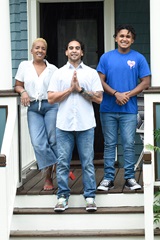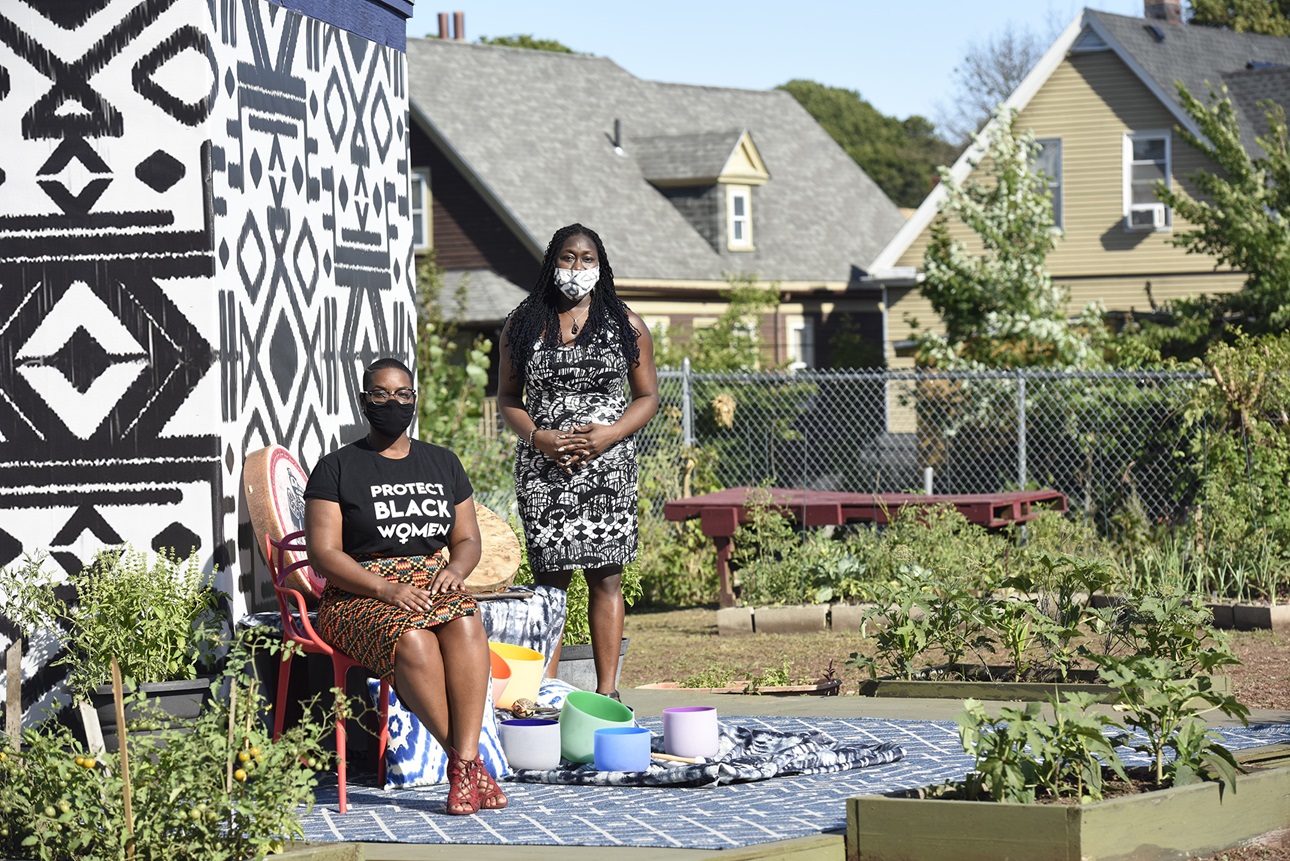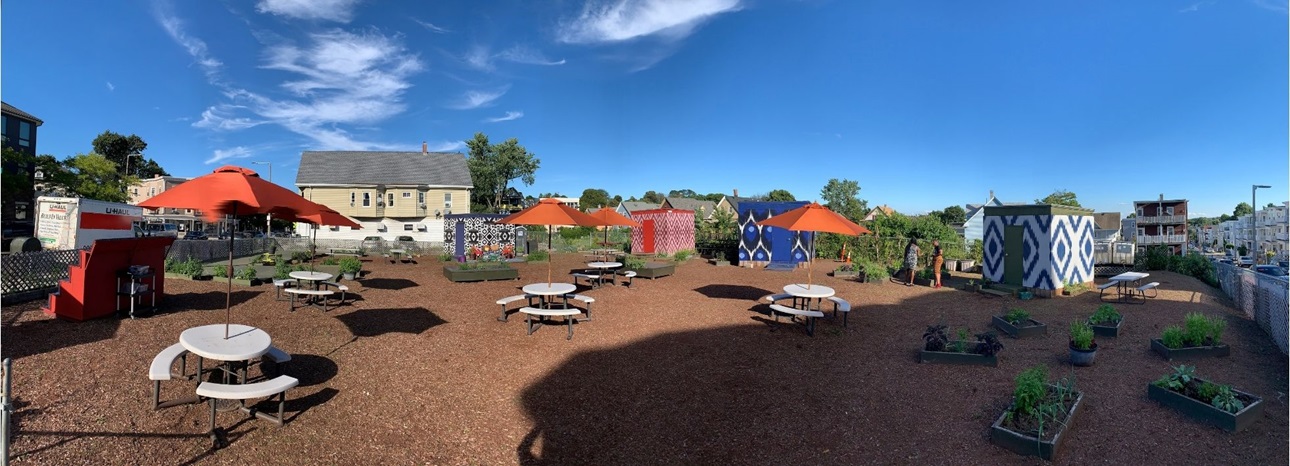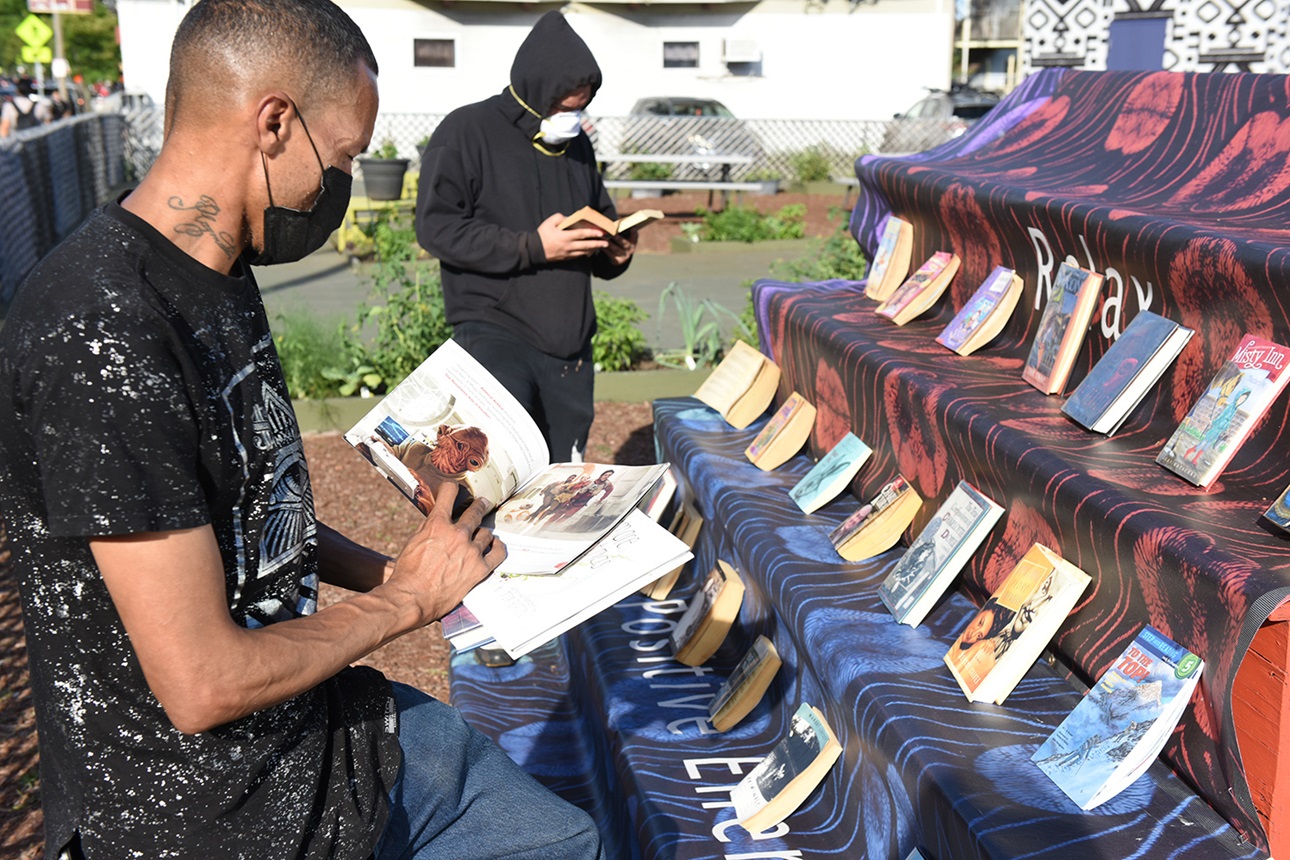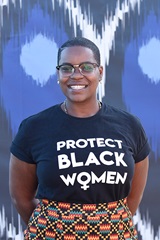Black and Brown People Creating Systems Change
Jhana Senxian
Founder & CEO
The Guild
Tell us about yourself: What events have shaped you, who has inspired you?
I have Jamaican roots but was born here and grew up in affordable housing, right at the corner of Seaver and Blue, directly across from Franklin Park at a time when we had the Kite Festival, the zoo was free, there were major concerts in the park and huge maple and oak trees lining Seaver St. You could walk and get on the elevated train at Egleston Station, everybody knew everybody, and what one family didn’t have, they could borrow it from another family. I am the youngest of four. Around us, people weren’t formally educated or successful and I understood as I got older that there were a whole lot of serious struggles, but being a kid, I wasn't too aware and so, I didn’t experience it that way. Our house was filled with beautiful plants, incense, lots of books, great food—both soul food and island food—there were dark beautiful wood floors, always a single candle in a tall glass, burning for protection and luck. I remember a lot of beauty around: the rooms, the music from the radio station, WILD, every Saturday as we cleaned the house before folks started to visit for conversation, food, connection.
The people around me, my grandmother, uncles, my mom, aunts— family friends— were very artistic and loved beauty. They were philosophical, spiritual, open minded, interested in the world. Boston beyond the neighborhoods could be hard but we still went everywhere around the city. It made our community seem so much more full and beautiful to me. Neighbors watched out for each other, especially those from the islands and the south. I absorbed and loved all of it. As a little kid, I was shy and pretty introverted. I often didn’t want to go out and play. My favorite thing was to be tucked behind my mother’s big armchair as she hosted, debated, and laughed with family and friends. I was all ears as they talked about the world and also how there was so much brilliance, strength, and creativity in our community. It really didn’t matter what money you might not have or what menial job you did have, your cultural world, self-expression, imagination, critical mind, wisdom and integrity, make you rich in a way that nobody can ever take away. That vision and experience of the world comes directly from my mom and aunts and from my grandmother. So much of who I am and what I value today can be directly traced back to that experience growing up around strong Black women in a family and community of love and beauty.
Can you talk a bit about how you entered, and then exited, your academic path? It sounds like a lot of women, particularly your mom, deeply influenced your sense of purpose and relationship to your community.
Absolutely, my mom isn’t active these days but was a radical poet, educator, and mentor for a lot of women and young people. She did creative writing and poetry workshops all over— in housing projects, with immigrant women, in the schools with youth, in the community with young mothers, and with seniors even in the complex I grew up in. She left being a secretary on the emergency floor at City Hospital to be a poet full-time and from when I was maybe 12, I was always with her at her readings and events. She was a part of radical women writers, lesbian artists, and activists circles, especially around Jamaica Plain and Cambridge. These women, who are part of local, radical history, were like aunties to me. My mom has been published and one of her poems is actually engraved into a marble sculpture at the Mass. Ave T station, from when it first opened. Her piece is called “Drum” and to me, it is about finding your voice, self-expression and physically and energetically manifesting harmony and peace, for yourself and the world. [Jhana’s mother is Sharon Cox Howell.]
My mom always encouraged me and thought I could do anything—anything in the world. She recently reminded me of the moment I understood the gulf between my experience of our community and the dominant, media narrative. I was probably 11, and we are watching a segment about people and life in the ghetto and it looks really dangerous, ugly and bad. I was wide eyed, absorbing this horrifying story and blurted out to my mom, “Oh, my goodness, I would never want to go to a ghetto. It’s terrible!” And she looked at me surprised and amused and said, “This is the ghetto; here. We are what they’re talking about.” I was really shocked. The story painted a picture filled with violence and ugliness and erased every other aspect of our experience, beautiful people, care, joy, and support. Our neighbors were regular people, someone’s son or mother. But also, when you are from a neighborhood like mine, you are often told that to ‘really’ be a person of value, you need to get as far away from your community, as possible—away from people like yourself. You need validation from outside because our communities are framed as deficient. There are negative spaces known by certain names, filled with certain people, a certain brutal experience. It's an old narrative told about our communities and people.
When it came time for college, I first thought that I would be an artist and so, for a year, I went to Bennington College and studied painting, sculpture, ceramics and creative writing. It was a beautiful and strange environment but I came to the decision that I could not afford to be an artist and so I took time off to rethink my choices. I lived in Taos, New Mexico and experienced issues of race and privilege from a whole new perspective. I had a job where I was able to work alongside and get to know women elders from the Tiwa Pueblo. There were fewer than a dozen Black people living in the town and so I got an intense introduction to both cultural commodification and silencing, through a First Nations lens. When I finally returned to Boston, I applied to a couple of schools and went to Brandeis. There, I really dove into becoming a scholar focused on race, class and gender. I did really well there and even kept up the creative writing and poetry.
After I graduated, I went to Harvard for a Ph.D. in Social Anthropology. I was obsessed with the process of cultural change. My cohort was extremely small, diverse, and engaged. Though it wasn’t clear how, we wanted to ‘do something’ with the access we were given and the knowledge we were gathering. I had field experience in West Africa but chose to immerse in mobility and hierarchy in the Indian Ocean region. I wanted to focus on the cross-cultural experiences of Black women and so followed the issues to Europe. In Italy, I added the issues and politics of urban space and place. The concept of alchemy also came into play there and I was excited to start my dissertation. In order to start writing, you are supposed to get distance from your field site and so I moved to Berlin and ended up gathering even more insight. I was very interested in what people consider negative space, identity and, of course, how people engage, challenge and transform all of that. When I would call home, my mom would tell me how proud she was of me for doing what I was doing out in the world, but she would also ask me if and when I would come home and engage here, in my own community.
"I realized then and there that I would base my work and life on actively contributing to the world. I didn’t just want to excel at working the system or being a token. I wanted to create new pathways and new systems."
Is that why you decided to come back to settle down again in Boston?
Maybe only subconsciously because consciously, I had no intention of staying. I came back because my Ph.D. advisor insisted that I needed to return and gain teaching experience and so we could work more closely together as I ramped up to defending. I actually really loved teaching, mentoring and being a thesis advisor. I was surprised how much I was enjoying being back in Boston. My husband and I bought a house in Bowdoin-Geneva, just five minutes from where I grew up and where my mom still lives. Coming home was deeply healing. In the department, I chaired the graduate student committee to vet potential new professor hires. It involved hosting grad student interview luncheons at the Harvard Faculty Club where my grandmother cleaned tables, before I was even born. The first girl in my family to even go to college and here I was, wondering if what we studied and wrote as theoretical anthropologists—especially in elite institutions—changed anything at all. I started to explore ways that I could apply my training out in the world. I was also back in connection with other students in my department sharing our experiences as women and people of color. It seemed like many other pathways were possible. We also talked about the surprising mechanisms and experiences of silencing, manipulation, alienation. For too many of us, it came down to being ‘instrumentalized’ or facing consequences. For us as women and people of color though, it mattered more what impact we would have in the world and we didn’t want to just participate in supremacist systems. It was an issue of responsibility, legacy, and honoring both ancestors and descendants. I was stunned and disappointed the day I excitedly talked to a professor about my passion for being an applied anthropologist—active in the world and issues facing my community and communities like mine. I was met with irritation and was coldly told that “only failed theorists are applied anthropologists!” I realized then and there that I would base my work and life on actively contributing to the world. I didn’t just want to excel at working the system or being a token. I wanted to create new pathways and new systems. No matter how shiny the promise of an elite but passive and performative career might be, a gilded cage was not what my grandmother—my ancestors—wanted for me.
It’s becoming very clear how all of these experiences roll up to the work you do today. You also have experience in the private sector. How did your work on sustainability start?
Well, when I pressed pause on my program, I wanted to find new access points to action in the world. I had not imagined a career besides academia, in many years. It felt all new and I was quickly hired by a global analysts firm, here locally. I was happy that I was still doing research but now it was in the private sector. I didn’t know much about the private or intergovernmental sector. I quickly learned how to apply my research and analytic skills to questions of supply chains, collaboration, green initiatives, strategies and outcomes. I launched the firm’s first sustainability and corporate social responsibility practice and got to get really deep insight into public private partnership and global development dynamics. I published some of the first reports to make a quantified business case for sustainability and CSR.
I was writing for some of the first environmental and sustainability focused media platforms and working with different firms that were developing solutions in the sustainability space for a whole host of industries. That prompted the UN Secretary General’s office to reach out and engage me as a special advisor on sustainable consumption and production, the Millennium Development Goals, public/private partnership, and more. At the same time, I was getting more and more involved in community meetings, neighborhood conversations and initiatives both in Grove Hall and Bowdoin-Geneva. I was talking to so many people who were not involved in civic action in the neighborhoods and getting insight into why. I was seeing all the blight around us, some recent, some decades old. I was starting to understand just how slow and uninspired many neighbors felt about the pace and process of change in our communities. I was hearing echoes of the negative narratives about who we are. In the most animated conversations I was involved in, especially along the Blue Hill corridor, the vacant lots and negativity they attracted were described like scars on the body of our community.
I also talked to a lot of older neighbors, my mom and aunts, who remembered the many spaces of pride and joy in Dorchester, Mattapan and Roxbury. Neighbors began to talk to me about depressing power dynamics and processes that render residents silent or just commentators on the things others envisioned and implemented—along with the racialized patterns around who was ‘legitimate’ or ‘credible’ to act. Who is considered to have the ‘capacity’ or deserve trust, support, and investment.
I started looking around more regionally and beyond. I was in constant conversation and movement and I again connected to all the wisdom, talent, and love that has always been at the core of our communities. I had an opportunity to start my own sustainability research and advisory firm and while I was still focused globally, professionally, I did get to do a few advisory projects locally. That experience led me to shift to directly engaging with the city and my neighbors. I worked with DND and city lawyers to come up with a temporary licensing agreement so that as residents, we could create interim development projects on city owned land. It changed city policy. We went into blighted sites to design, build, plant, program and steward new venues for wellness, urban agriculture, learning, creative expression, connection, celebrations, local business promotion, peace and healing. It was a blessing that we just came together as intergenerational neighbors and started creating beauty, joy and a feeling of care and safety, for ourselves and for one another. BIPOC neighbors and a handful of allies from across Greater Boston showed up and big, magical things would happen. It created a sense of pride and ownership -- It was beautiful. Those were the first outdoor sanctuaries. The Guild shifted from research to action as a Black and Brown community ecosystem. That was in 2012.
How has The Guild engaged in the complex challenges facing the community -- the city?
Eight years ago, we started an intense and wonderful period of many firsts and innovations. We held the city’s first Playway and again our open space work changed city policy and created positive partnerships with the city across two administrations. From the start, we took a holistic approach with an eye toward culture change and shifting power. We were responsible for bringing Open Streets | Open World to Blue Hill Ave, two years in a row, which showcased POC talent, businesses, interfaith action, and healthy lifestyles, and attracted over 14,000 residents. Today we own and operate out of our 24,000 square foot Sanctuary, with healing designed spaces for wellness sessions, retreats, credentialing, development and resident association meetings, cultural events, sacred art exhibition, community and economic development.
We started to scale our work when after an intensive community process we were asked to lead and manage the work of the collapsed Boston Collaborative for Food and Fitness. This gave us the opportunity to apply our process and principles to issues of race-based health disparities, systems change and racial justice. We created a POC resident-led network that established new systems of participatory community investment and the governance of shared resources. We incubated and accelerated POC healing and wellness businesses and initiatives, in Dorchester, Roxbury and Mattapan and invested over $250,000 into new community capacity, leadership, infrastructure, resources, networks, and opportunity. In this way, we modeled and manifested a paradigm shift that reclaimed community voice, power and action. Our case study of the work was published in a national peer reviewed journal with one of our young people as co-author. We are very intentional in everything we do so that any one action has multiple benefits that address a variety of challenges or disparities. You can view or understand the work from multiple directions: environmentally, socially, culturally and economically. Our intention is to achieve positive forward movement on all of those levels.
Since April 1, it’s been all about COVID response. Three days a week, we have our relief pantry. We are providing cleaning supplies, personal care toiletries, diapers, wipes as well as senior care and denture care. We distribute fresh food, grocery vouchers, bags of beans and cooked food and go out of our way to support our local businesses of color. Early on, we provided emergency funds for health related transportation and connectivity. We hire community people to make fabric masks. We think a lot about the emotional stress that our neighbors are dealing with and so also provide books, puzzles, games, and stress relief items. Some of our healers have been volunteering handwriting beautiful cards for quarantined households, families, and elders. They also come and use the filming spaces we have set up for them to bring their healing modalities virtually to folks. Since we began the relief work, we have already supported over 44,000 POC residents and are looking for more ways to be there for our neighbors. We are even discussing opportunities to partner around testing.
What do you see as the biggest challenge facing Boston right now? As you look ahead 10 years or more, what big ideas do you have that would create a stronger city and deal with those challenges?
Boston’s biggest challenge right now is to dismantle the systems that result in race-based inequities and disparities all across our city. We need concerted effort to interrogate the institutionalized cultures, power dynamics, practices, and narratives that seek to diminish, erase and subordinate community vision and action. We need leaders and institutions to step up and hold themselves and one another accountable for building respectful, generative and authentic partnerships with communities and embracing new ideas, models and action. Old and racist paradigms have gotten us here, so I hope to see serious investment in BIPOC, community-led and -owned action and leadership. New systems, solutions and positive outcomes for our communities, must be created from within our communities. And I understand that this will not be easy to do but we have seen the disastrous results of the status quo. Conscious and positive cultural change is hard, but it is worth the discomfort to be a part of it takes courage and humility from all of us. This is why expanding and scaling what The Guild does, is my big idea! We are developing innovative and holistic models of community action and partnership around BIPOC health, capacity building, community infrastructure, housing, businesses and jobs. We have really wonderful and committed cross-sector partners who are very excited for thought leading systems change with The Guild and we have never been more ready to stand in our own light—and scale.
